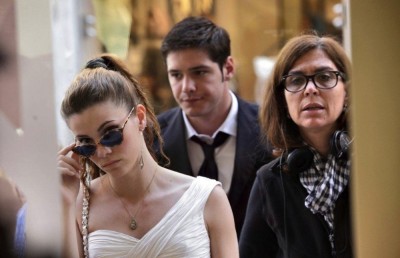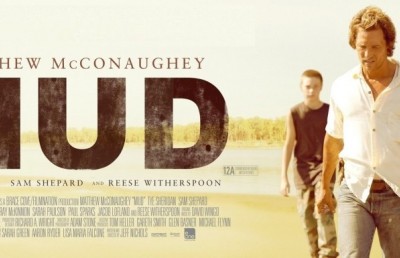Friendship, Ideas, Sex, and a New Movement: A Dangerous Method, directed by David Cronenberg
Analysis Can Lead to Understanding, Freedom, and Transformation
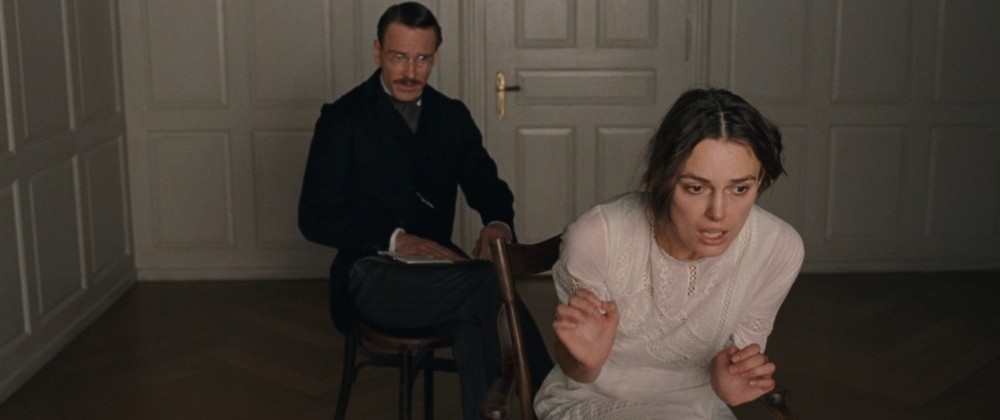
A Dangerous Method
Directed by David Cronenberg
Starring Keira Knightley, Viggo Mortensen,
and Michael Fassbender
Produced by Jeremy Thomas
Sony Pictures Classics, 2011
Much of our culture is geared toward attitude and emotion, rather than ideas. The forms of civilization—standards and values, ideals of behavior, the great arts and philosophies, the relations of social power—that once endowed and interpreted the image of a man or woman who embodied personal control, cordiality, and knowledge, as a figure of mastery and respect are descendant, not ascendant. The ideals of the gentleman and the lady no longer inspire or threaten. The ordinary person participates in democracy not only with liberty but with rights. High culture has been succeeded by mass culture and its resources—television, radio, newspapers, comic strips, telephones, travel by car and train and plane, fast food, popular music such as rock, computers—and film. The person whose energy is a formidable force, and whose words are direct and rough, the person who seems possessed by his personal appetites and drives, the person who seems wild, is more likely to be admired, and that in the name of authenticity or even integrity. It can be difficult to recall any other time; in fact, it is only through works of history, and serious art past or present, literature or old paintings or classical music or film, that we can have a vivid sense of that past time. It is easy to blame the more damaging aspects of the cultural change on the rebellions of the mid-to-late twentieth century: on the increased regard for folk and popular culture, and the integration of chaotic minority social practices, and the revolutions on behalf of sexual freedom, and the greater experimentation with recreational drugs. Yet, the roots of change can be identified even earlier: in the works of two culturally bourgeois but intellectually radical Jews and their associates, that is, principally, the works of Sigmund Freud and Karl Marx, the former analyzing the inner life and the latter analyzing the social world. In David Cronenberg’s beautiful film A Dangerous Method, a film of sunlight and darkness, of reason and passion, of convention and its subversion, we are given a view of that earlier time, with the beginnings of the respectable professional and public consideration of how damaging sexual frustration and disturbance could be.
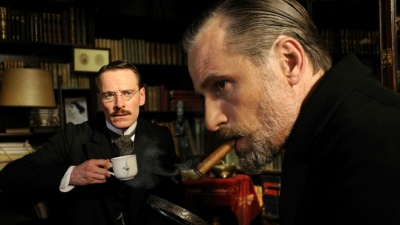
The key to the film A Dangerous Method, with a screenplay by Christopher Hampton based on his own theatrical play, The Talking Cure, that was itself inspired by a book, John Kerr’s A Most Dangerous Method, is not the key that one expects it to be: the beautiful young actress Keira Knightley plays Sabina Spielrein, a Russian Jewish woman who arrives on the doorsteps of the great Swiss (Zurich) clinic where works a gifted admirer of Freud, the Swiss doctor Carl Gustav Jung, a Protestant; and she is brought in feet first, hysterical, screaming, laughing, disturbed by childhood memories of abuse that humiliated and excited her. Intelligent and intuitive, the girl had wanted to be a doctor too, though her current condition would seem to make that much less likely. It turns out to be the experience that gives her special insight in the field of psychology. Keira Knightley’s performance is informed by study and observation of hysterical patients; and she denies her beauty, and deforms her features, to bring us an accurate but strange portrait. Sabina Spielrein’s twisted personality is easily perceptible; and Knightley’s work is admirable—and my only reservation is that, very understandably, her deeper soul, or spirit, is buried within the mechanisms of bodily movement (it is not until she is healthy again, that she begins to glow with the individuality and warmth I recognize). Michael Fassbender as Dr. Carl Gustav Jung introduces himself to the disturbed young woman, and his proposed method of treatment, an hour or two of talking, with the doctor sitting behind the subject of analysis, a treatment of talk in which she can describe her experience and discover the cause of her damage. As Jung moves behind Sabina, she raises her arms in defense, expecting abuse; and she talks about being incapable of standing humiliation, recalling her father’s anger and disciplinary practices, and her father’s forcing her to kiss his hand after he spanked her. Sabina is conflicted between speaking and withholding the truth, resulting in strange clenched-mouth gestures—opening and closing simultaneously.
Jung describes his new patient to his wife, Emma (Sarah Gadon), a beautiful, intelligent, perceptive, shrewd woman, well-mannered and supportive. His wife thinks the girl sounds like a good candidate for the talking cure that Freud has advocated and which interests Jung. Jung had yet to establish a significant public reputation: educated in medicine in Basel and Zurich universities, he was spending much of his time giving physical examinations. Sabina Spielrein herself is wary, an example of a distrust for a novel experiment; but when Jung beats the dust off her fallen coat she has an excited reaction—the connection between spanking and pleasure—that leads to an insight and the beginning of her recovery. Jung asks her to assist him in his psychological studies; and his wife Emma (Sarah Gadon) is their first shared subject that we see—and that work helps restore Sabina too. They record, measure, and discuss Emma’s responses to a survey of words, finding that she seems nervous about family matters (without being told, Sabina guesses that the woman is Jung’s wife, who is apprehensive about her pregnancy). Yet, Sabina has habits and anxieties that recur: she fears that something is in her room at night, imagining it is a cat, and imagines something squirmy on her back. It is a fantasy of fear and excitement; and Jung intuits that it occurs during masturbation (the fantasy may be infused with a memory of childhood abuse: it is not clear if her father’s abuse was only physical, or also sexual. Did her father masturbate while her back was turned and he was spanking her?). Sabina confesses her excitement at being spanked, and calls herself vile, filthy, corrupt, judging herself someone who should be condemned to isolation; an example of the morality of the time. Yet, speaking of the experience with another person, with Jung, is healing.
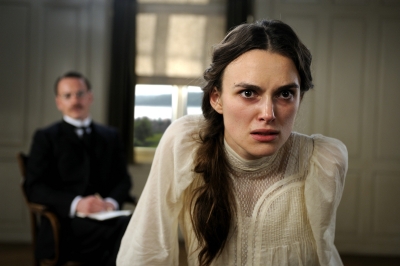
Carl Jung and his wife visit the master philosopher of the psyche, Sigmund Freud, in Vienna, where Jung eagerly eats with Freud’s family and has a long discussion with the master. Freud is older, and the two men are at different stages of their careers, something that can mean complement or conflict. The Freiberg-born Freud when very young had fled from anti-Jewish violence with his parents, settling in Vienna, where Freud attended university, studying medicine, specifically the human nervous system; and upon graduation, his hospital work focused on psychiatry, before he became a university lecturer in neuropathology. Freud traveled to Paris and studied cases of hysteria at a mental hospital, Salpetriere, with Jean-Martin Charcot, who advocated hypnotherapy; and returned to private practice in Vienna. Freud collaborated with physician Joseph Breuer on work that discussed the source of hysteria in repressed energy, for which a reenactment of original trauma was part of the treatment. Freud moved from hypnosis to free association as the principal method for articulating the nature of repressed material; and in the analysis of dreams he found familial conflicts involving hostility and sex. Sigmund Freud’s published works include The Interpretation of Dreams (1900) and The Psychopathology of Everyday Life (1904), books that garnered both admiration and denigration. Meeting colleagues such as the Hungarian doctor Sandor Ferenczi and Carl Jung gave him hope that the work he began would be continued. Freud welcomed colleagues and disciples. In A Dangerous Method, Michael Fassbender as a pale, slim Jung is alert and fastidious, with his appetite, intelligence, and humor sometimes breaking his personal and professional composure. Jung, who has used Freud’s work as foundation for his own, is looking for permission to go further with his own explorations. Freud and Jung quibble over clinical terms—whether to use the word libido, or psychoanalysis rather than psych-analysis—and they discuss Sabina, who does not fit Freud’s diagnosis. Freud, as played by Viggo Mortensen, is suave, deep, a little sly; and it can be funny when we see him comparing the comfort Jung has in the material world with his own limited circumstances or restraint. Freud, while they dine in a café, talks about the opposition their professional movement faces for its content, and also for the fact that many of its members are Jews. (Should it surprise that two members of a repressed tribe, Freud and Marx, would create philosophies that acknowledge and respond to social repression?) Back in Freud’s office, Freud considers one of Jung’s dreams, involving a harnessed horse, seeing the frustrated ambition that Jung already recognizes in the dream but also adding the possibility of sexual frustration to his interpretation.
Fassbender as Jung appears to be a nineteenth-century man who is discovering twentieth-century knowledge; and that is most vivid when he is with Sabina or Otto Gross. Otto Gross is a freedom-seeker, a hedonist, the father of children with different women, and he is a doctor and a patient; and as played by Victor Cassel as a bearded, smooth-talking sensualist (his speaking voice is musical), when Jung and Gross are together it is like having the past and the future in one room. Together Jung and Gross wonder, How much of neurosis is sexual? Is the true goal of analysis the discovery of freedom, whether freedom leads to joy or despair? Or health and self-transformation?
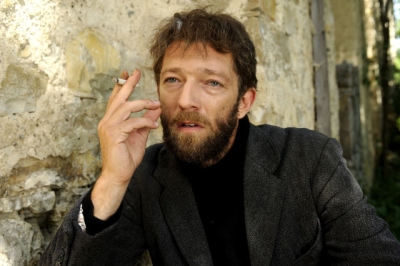
Jung discusses both Freud and Gross with Sabina. In the scene in which Jung first discusses his apprehensions about Freud’s perspective to Sabina, and the questionable coterie surrounding Freud, one sees how precarious intellectual collaboration can be. Freud may be brilliant and ground-breaking, but that does not mean that all will agree with him. Jung has a regard for spirituality, and wants his patients not merely to understand their illness but to use their understanding to become whom they want to be. Increasingly, Jung would resist the theory that all neurosis is sexual in origin, seeing the libido as a life force, with many problems of conflict or frustration not having old sources, rooted in childhood, but new, in current relationships. Listening to Jung’s comments about Freud, Keira Knightley as Sabina looks thoughtful but somewhat tense, haunted and severe, halfway between hurt and healing, and this is probably the part of her performance I admire most. It is subtle. When Jung tells Sabina that he finds himself increasingly persuaded by Otto Gross’s embrace of promiscuity, she is attentive, recognizing the personal possibility in Jung’s words. She herself talks about the clash of destructive forces as leading to something of value. She thinks that people are creatures of ambiguity and difference and can benefit from bringing their differences together; and says there is something male in every woman, and female in every man, or should be. She kisses Jung; and he goes to her apartment and they kiss and begin a sexual relationship.
It is an example of the liberty of wealth as much as sensibility that Jung’s wife suspects their relationship but is restrained in her response. It is her money that allows the Jung family a large new house and Jung the boat with red sails, red the traditional color of passion, which he has wanted. It is that generosity, as much as his wife’s affirming that Jung is a good man, that motivates Jung to try to end his affair with Sabina—but Sabina says his relationship with his wife is different from his relation to Sabina, and that while the love he makes with his wife is tender, what Sabina wants is ferocity. “This is another thing in another country,” Sabina tells Jung. Both Sabina and his wife, at different times, asking for a renewal of intimacy, reach out for one of Jung’s hands; and Jung takes Sabina for a ride on the boat his wife has bought him. When Jung’s wife does respond to the affair, it is not with shouting or threats, but with recourse to social opinion—she expects the disapproval of others to dissuade the bourgeois Jung.
Otto Gross escapes Jung’s clinic, and Freud rejects Gross as an addict, with Freud naming Jung as Freud’s son and heir, warning Jung away from mysticism. Jung insists on his own path, which includes spirituality; and Jung begins giving Sabina the spanking she wants. One digression from established protocol seems to enable other digressions. In work and life, Jung moves beyond convention; and his ideas are transformed and transformative. On the boat ride in Switzerland that Jung gives to a visiting Freud, Freud tells Jung of the gossip in Vienna about Jung and Sabina, an affair Jung denies. (The sunlight in that scene and other scenes is a happy accident, according to director David Cronenberg, who said he would have filmed on cloudy days if that was what he had found; and the warm light offers balance—beauty and energy—within cinematic exploration of a dark theme. The film’s cinematographer is Peter Suschitzky, with production design by James McAteer; and the film is edited by Ronald Sanders.) Jung’s wife brings up the subject of the affair too, and Jung again tries to end the affair; and Sabina angrily cuts Jung’s face. It is a predictable mess of emotion and sex, in which personality and place conflict: these erotic temptations and disappointments may be timeless. Sabina confides in Freud, but Jung again denies the affair, and then Sabina insists that Jung tell the truth so that Freud may become her analyst and teacher. Jung tells Freud the truth, though he would rather Sabina not become Freud’s patient or student. Jung is more convinced of his philosophical disagreement with Freud, and his personal resentment of Freud has increased.
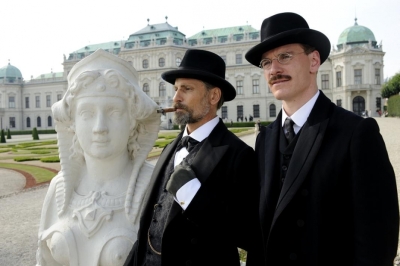
Yet, Sabina Spielrein has her own sense of mission—of work that she wants to do; and she is determined to let her instinct inform her intelligence. It is arguable that she, like Jung, like Freud, is pursuing a path to knowledge that is older than it looks. How old? If one wants to be more precise, and more perverse, one can identify the European age of enlightenment’s concern with knowledge and truth as a deeper source; and deeper still the probing philosophy of the pagan ancient Greeks. It is arguable that civilization always contains its own other, the raw stuff that must be transformed, exploited, repressed, or accepted as is; and that civilization is always increasing the amount of truth it can accept. When Sabina writes her dissertation and submits it to Jung for inclusion in an anthology he is preparing, their discussions—about the human instincts for sex and death; about the obliteration of the ego during sex—allow intimacy, and their affair resumes. Jung whips Sabina again, both of them observing her responses for insights: her fixation is a dominating aspect of her personality, an act and image around which energy and meaning have become concentrated, a complex. Sabina leaves Zurich for Vienna, and Freud affirms her talent and their shared Jewish heritage, denying that an Aryan ideal—as expressed in Richard Wagner’s musical work, or as embodied by Jung—can be of use to them. Unfortunately, Jung blatantly insults Freud; and Freud rejects Jung. Sabina, by now married to a kind Russian Jewish doctor, and pregnant, is a conduit between Freud and Jung but cannot mend the break; but she, interested in child psychology, would train analysts in Russia, and later, very regrettably, would be killed by the Nazis. The film, which began with Sabina arriving to meet Carl Gustav Jung, ends with Sabina leaving Jung; and when we last see Jung he is sitting, quiet, plagued by nightmares, premonitions of a coming world cataclysm. Jung was to be the author not only of Psychology of the Unconscious (1912), a work interpreting cultural symbols, and Psychological Types (1921), a work on introversion and extroversion, but also of Two Essays on Analytical Psychology (1953), Psychology and Religion: West and East (1958), and The Structure and Dynamics of the Psyche (1960). Carl Gustav Jung, the founder of analytic psychology, was a doctor, writer, teacher, and organization builder, and he would outlive Sigmund Freud and Sabina Spielrein, and live long enough to see some of the fruits of the modernism that he and his friends helped to bring into being. They were part of a change in consciousness that affected science and society, liberating human energy and possibilities. It may be an irony that in our time, emotions are not repressed; rather, we are expected to express them—but preferably only the right ones, which now are the rowdiest ones, the most rude.
(Article submitted June 2012)




